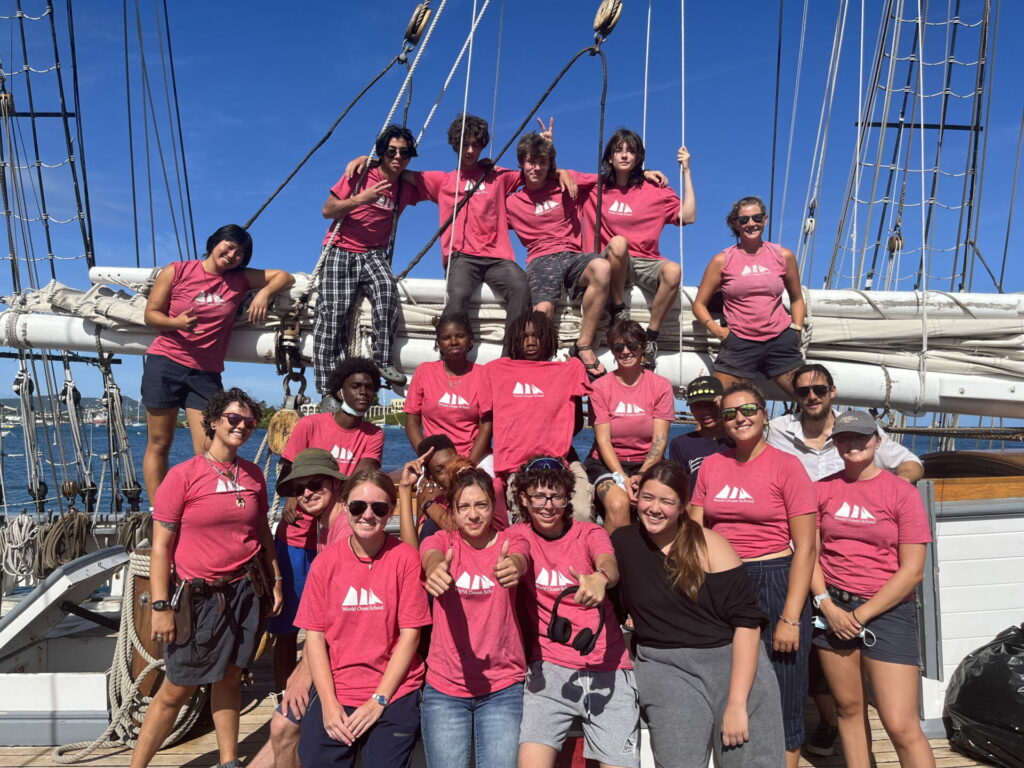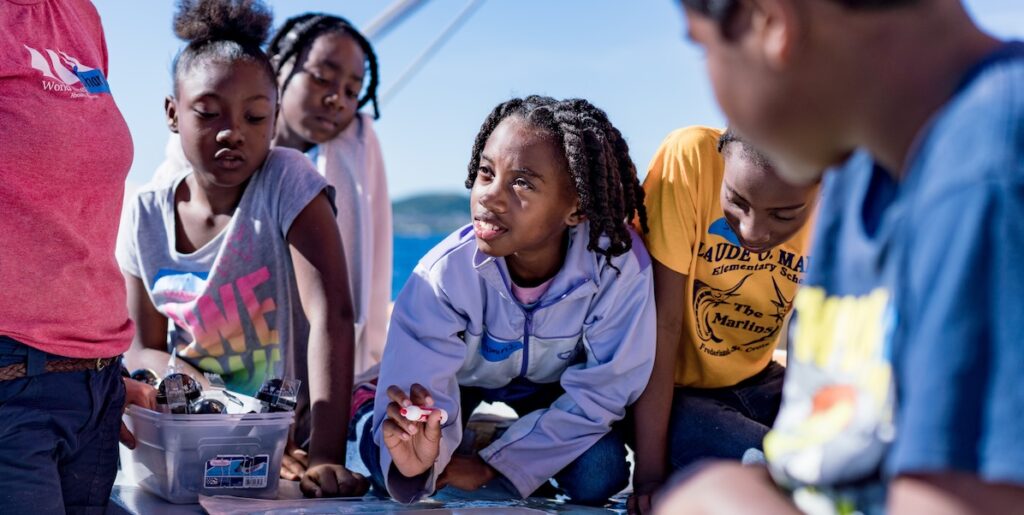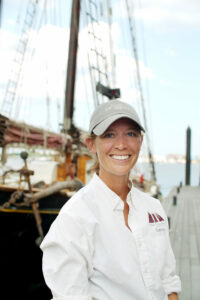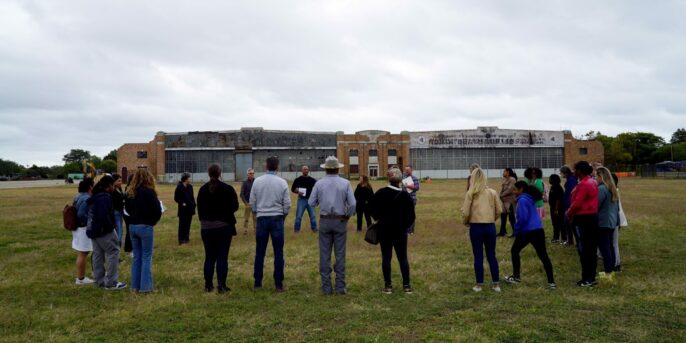Aboard a tall ship, learners step onto the bowsprit, suspended over the open ocean, trusting both themselves and their crew. This is just one of many challenges they face through World Ocean School’s hands-on sailing programs, where teamwork, responsibility, and confidence grow with every task. We spoke with Captain Jill Hughes about how real stakes, whether steering through narrow waterways or tackling tough jobs on deck, push learners beyond their comfort zones and reveal their capabilities.
Q: Could you tell me a little bit more about yourself?
Jill: My name is Jill Hughes, and I’m the Vice President of Programs and Advancement with World Ocean School. My background is as a mariner, particularly on tall ships with sail training. I came to World Ocean School as a relief captain. I spent a couple of weeks onboard in the summer, helping run some programs, then became a full-time port captain. With that, I was dealing with crew hiring, boat logistics, and haul-outs—ensuring the boat and the crew were happy. Since then, I’ve taken on the Vice President role, looking at the big picture of what the organization does and needs.
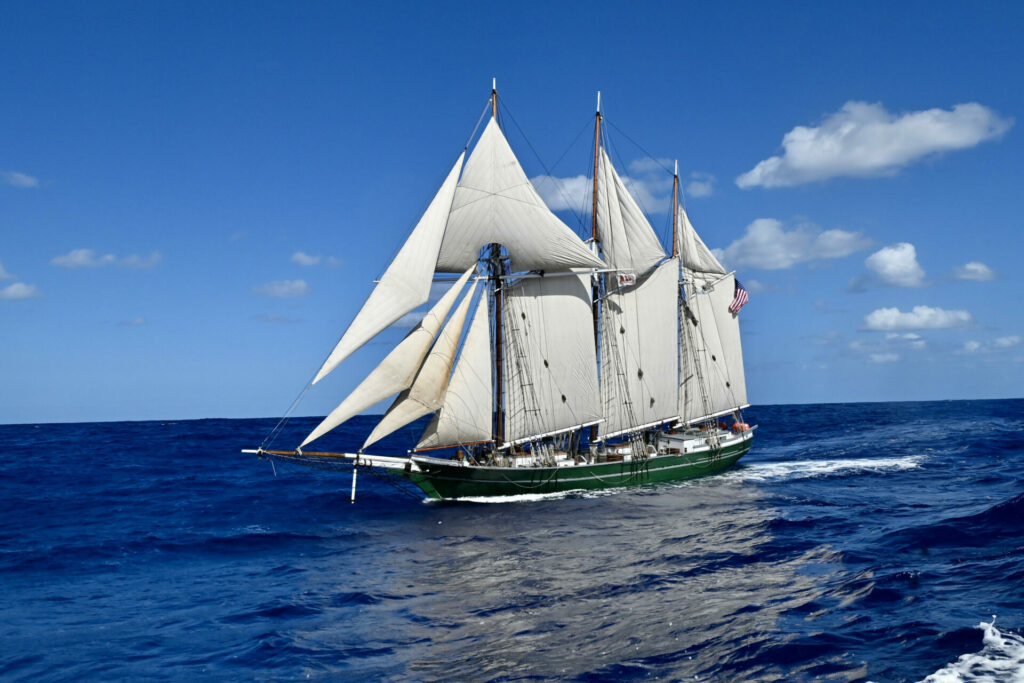
Q: What is the mission of World Ocean School?
Jill: We strive to create hands-on, immersive experiences that impact students and encourage them to be courageous change-makers in their communities. We do this through sail training, using our two tall ships to run programs and get students out on the water.
We form our programming around four pillars: trust, self-worth, communication, and teamwork. The tall ship is a great platform to build those skills. I think it’s really important to say that though we use a sailboat to do this, our goal is not for everyone to become a mariner. The vessel is the teaching tool to develop these soft skills.
The youngest students we have on board are in fifth grade, and we work with students through college. We’re based out of Boston in the spring and summer, and our winters are spent in St. Croix. In St. Croix, the bulk of our programming is geared toward public school students in fifth and sixth grade. We also run week-long programs with some private institutions, who join us in the USVI or New England. Our programs range from one day to several weeks.
Q: How do the four pillars shape the experience of learners aboard your ship?
Jill: I think what’s very cool about what we do is that the pillars and goals are not necessarily related specifically to STEM or sailing; they’re soft skills that develop out of the experience. And we think they’re valuable skills that students will keep with them for their whole life.
If we have a longer program that’s at least four days, we will focus on a pillar each day. For something like trust, we might ask the students to climb out on the bowsprit, which is part of the boat that sticks out in the front. When they’re out there, they’re actually over the ocean. The boat may be underway, and that can feel a little scary. They have the courage to go do it. They also have the trust in us to say it’s a safe thing. Also, they have trust in their fellow crewmates when they’re out there because if one of them makes a poor decision, it could affect all of them. That’s one of many ways we build upon the pillars and bring them to life.
Not everything we do aboard is conventionally fun. We like to call some things “type two fun,” which is a nice way of saying it’s a job that has to be done, but no one wants to do it—like doing dishes or washing the deck. I think that these tasks can be helpful for students because it shows that you can do hard things, and it’s okay. We consistently see that when things are challenging, many students choose to do the tasks. There’s something about a tall ship that authentically creates that type of confidence in students, where they’re willing to step out of their comfort zones to try something new. Once they’ve accomplished something, they’re more willing to try something intimidating again, whether it’s on or off the ship.
It’s just incredible to see how the kids engage with the ship, each other, and themselves while aboard.
Jill Hughes
Q: How do these leadership opportunities shape their development beyond the sailing program?
Jill: There are opportunities on our ships that have real consequences that are not contrived. When you trust a young adult to do something, I am always impressed by how they step up. When operating in New England, we often pass through the Cape Cod Canal. Some boat operators would never dream of having a student at the steering wheel to go through this narrow waterway with a lot of currents. With the right sort of supervision, though, as we offer onboard, you can. The stakes are high, and students might be thinking, “If I don’t do a good job, there’s a very real consequence. But someone is trusting me to do this job, so I’m going to meet the occasion. I’m going to take it seriously.” It’s the same thing when we let the students climb up the rigging or on the bowsprit. They have a harness on, but I still think the responsibility and mutual trust they feel is very palpable for them. From a leadership standpoint, it’s wonderful to see them rise to the occasion in such authentic ways. We work with the learners to develop these skills, but we also lead by example as a crew.
Another thing that’s important on a boat is that everyone has a role to play—no one is just there to be a passenger. Everyone has to clean. Everyone has to do some navigating. And again, it’s not contrived. Those are just the requirements of the ship. Some days, you are going to be the leader who says, “Alright, I’m organizing us to set sail today.” And some days, you’re not going to be the leader; you’re going to have to take instruction. It’s just as important to help the leader that day to be successful in their role. I think they’re all great lessons for the kids on board.
Q: What inspires you about this work?
Jill: It’s just incredible to see how the kids engage with the ship, each other, and themselves while aboard. One story that sticks with me was from when I was a relief captain. We had a group on board for 10 days, and about a third of the teens had a learning difference. That’s not how we marketed the program, but as long as you could live in a community and follow instructions in case of an emergency, you’re welcome onboard. One of the students was non-verbal, and he thrived on board. I’ve worked in sail training for such a long time, and I’ve never been a part of a program that really believed in kids and trusted them so authentically. I just saw the best in all of them. No one was treated differently because everyone had the same goals and responsibilities. I think this environment created great camaraderie for everyone on board. I was sold on World Ocean School from that point on. I had been in the sail training community for about 15 years, and even after all this time, I could still be surprised by the impact an experience like this can have on a young person.
